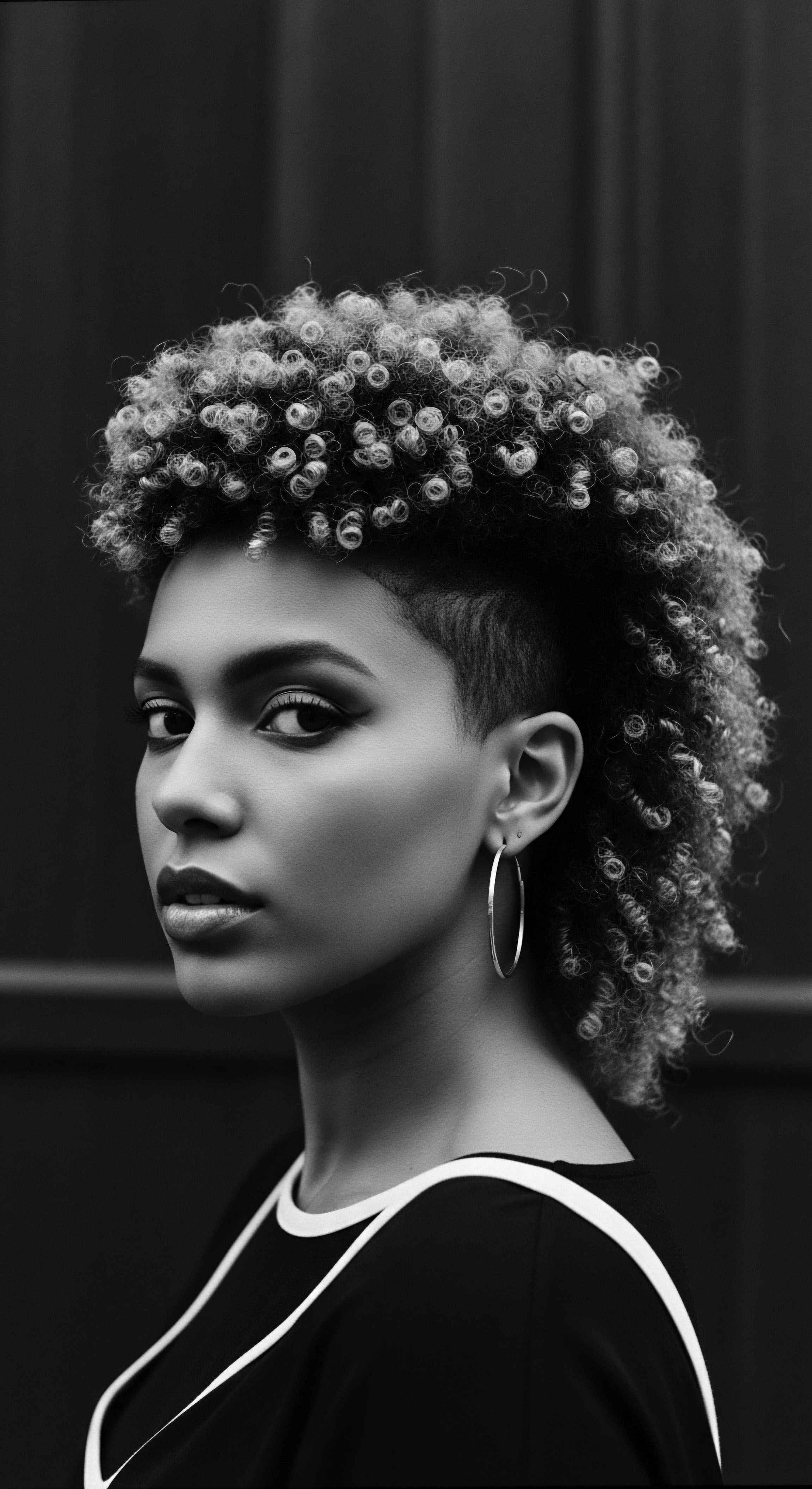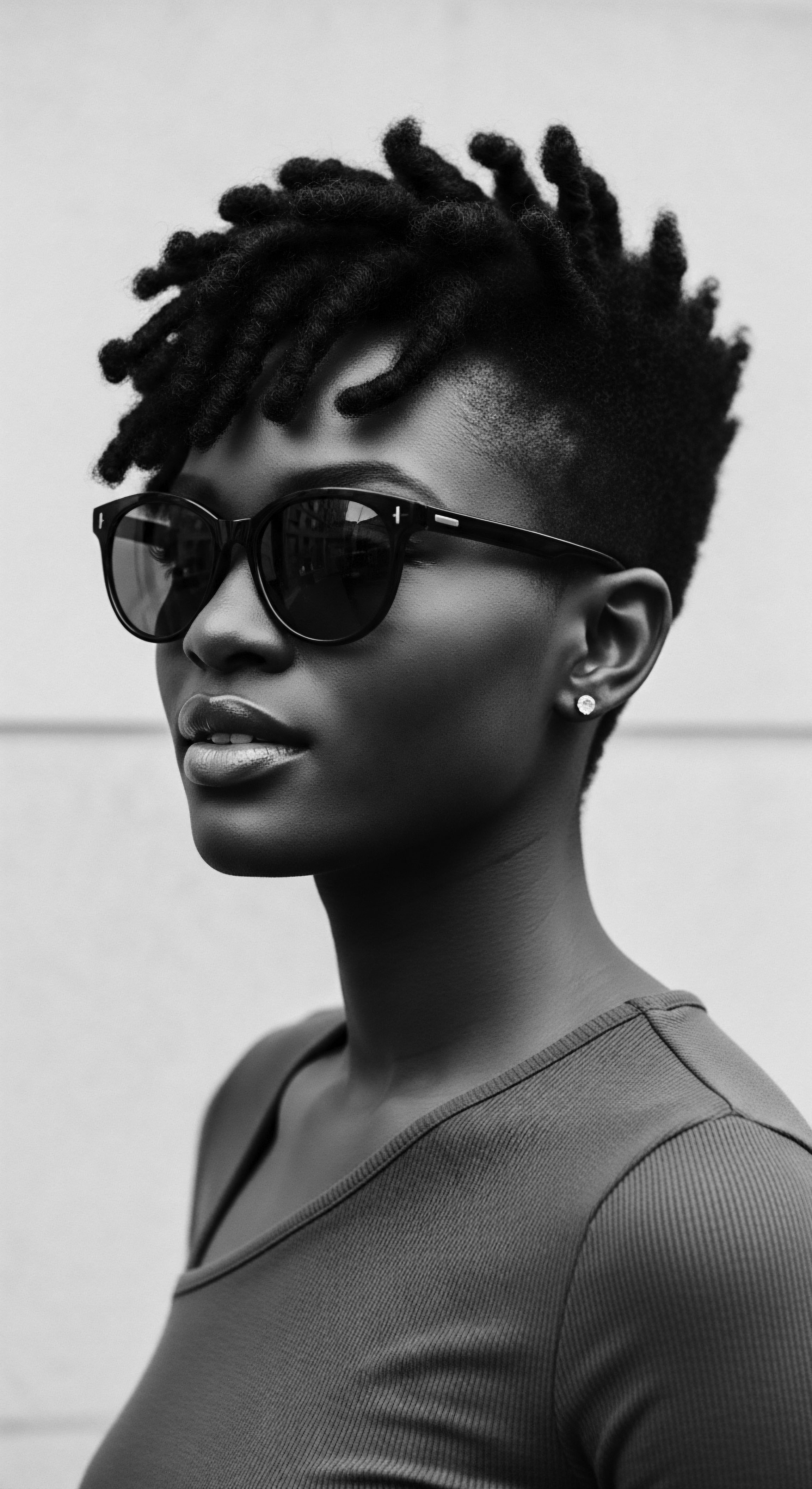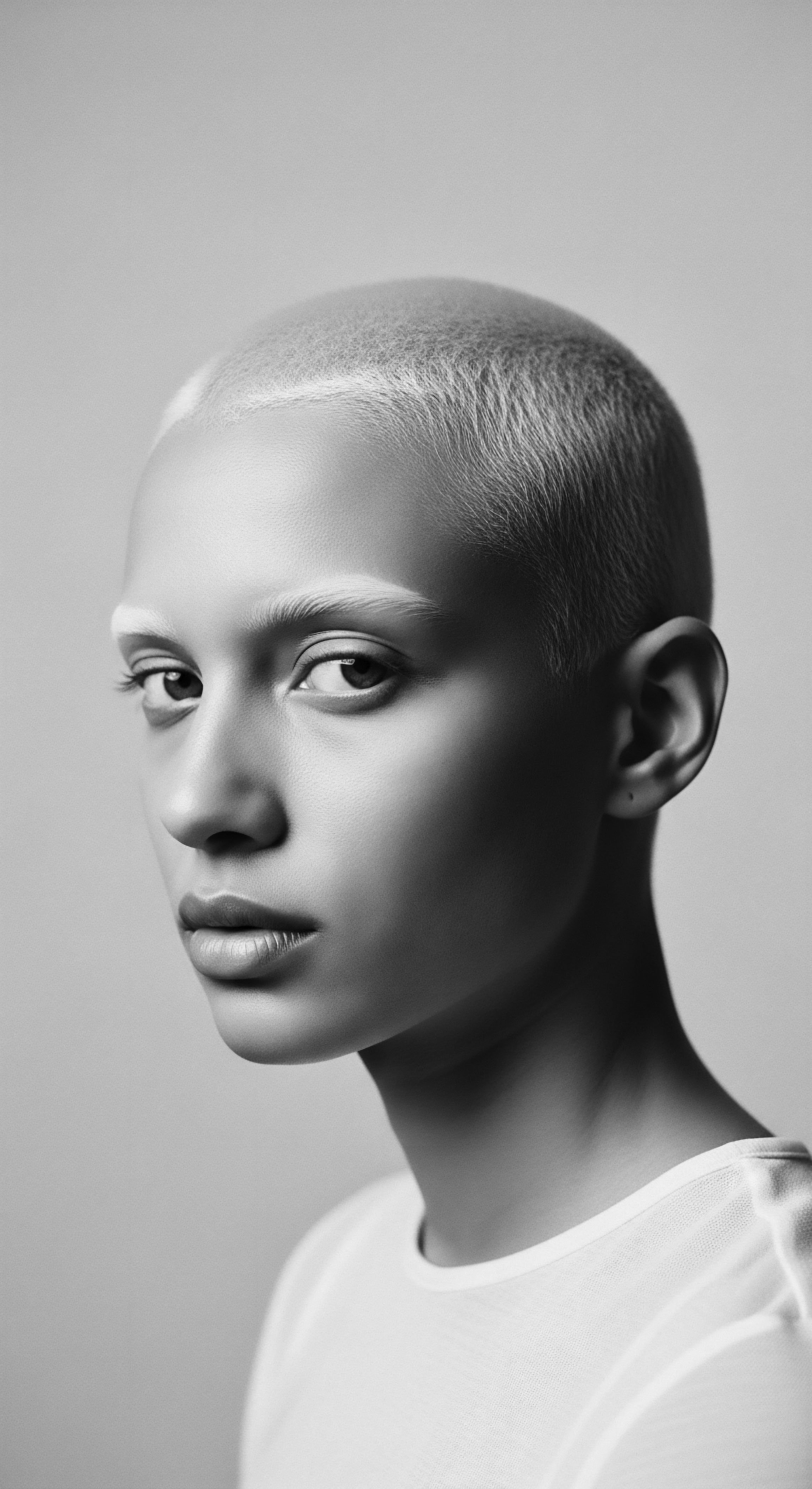
Fundamentals
The designation ‘Equatorial Hair Characteristics’ refers to the distinct biological and structural attributes commonly observed in hair types originating from populations historically dwelling within the Earth’s equatorial belt. This region, a vibrant cradle of human diversity, is also home to a remarkable array of hair textures, predominantly those known for their tight coils, intricate curls, and often substantial volume. The meaning of these characteristics extends beyond mere appearance, reaching into the very heart of ancestral adaptation and environmental harmony. Such hair is a testament to the body’s ingenious capacity for self-preservation, evolving over countless generations in response to the intense solar radiation and often humid climates prevalent near the equator.
From a foundational standpoint, the uniqueness of these hair types begins at the follicular level. Unlike the more oval or round follicles associated with straighter hair, equatorial hair typically emerges from follicles that are notably flattened and elliptical in shape. This particular follicular geometry dictates the pronounced helical trajectory of the hair strand as it grows, leading to the characteristic curl, coil, or kink patterns. This structural arrangement inherently creates natural air pockets within the hair mass, offering a degree of insulation against both heat and cold, a protective mechanism honed by millennia of life under the equatorial sun.
Understanding the elemental biology provides a gateway to appreciating the deeper heritage of these hair types. The cuticle, the outermost protective layer of the hair shaft, presents a unique configuration in highly textured hair. While all hair possesses cuticles, those found in equatorial hair often exhibit more raised or open scales, which can contribute to its natural propensity for dryness compared to hair with flatter cuticles. This inherent characteristic underscores the historical importance of moisturizing practices within traditional hair care, where natural oils and emollients were not just beautifiers but essential elements of preservation and health.
Equatorial Hair Characteristics represent a profound biological adaptation, shaping the very structure of hair to thrive in challenging ancestral environments.
The inherent elasticity and tensile strength of equatorial hair are also noteworthy. Despite its delicate appearance and sometimes perceived fragility, highly coiled hair possesses a remarkable ability to stretch and rebound, a property that has long been respected in ancestral styling practices. This resilience allowed for elaborate braiding, twisting, and knotting, styles that served not only aesthetic purposes but also offered significant protection from environmental aggressors, reducing breakage and preserving length. The traditional wisdom surrounding the care of these hair types often centered on methods that honored and worked with, rather than against, these innate structural properties.

Elemental Attributes of Equatorial Hair
- Follicle Shape ❉ The distinctive elliptical or flattened shape of the hair follicle gives rise to the unique curvature of the hair strand, defining its coily or kinky nature.
- Curl Pattern ❉ Hair strands exhibit tight, often Z- or S-shaped coils that stack upon one another, creating dense, voluminous formations.
- Cuticle Configuration ❉ The outer cuticle layers tend to be more lifted, contributing to increased surface area and a natural tendency towards moisture loss, necessitating intentional hydration.
- Density and Volume ❉ These hair types often grow in high density, creating a voluminous crown that historically provided natural sun protection for the scalp.

Intermediate
Moving beyond the foundational understanding, the intermediate meaning of Equatorial Hair Characteristics deepens into the interconnectedness of biological attributes with the cultural practices and historical journeys of communities whose heritage is rooted in these hair types. The inherent features of equatorial hair, such as its natural coiling and tendency towards dryness, are not mere biological facts; they are threads in a larger narrative of human ingenuity and adaptation. Ancestral communities, with generations of embodied knowledge, developed sophisticated systems of care that anticipated and responded to these very characteristics long before modern science could offer explanations.
Consider the concept of moisture retention, a central concern for highly textured hair. The raised cuticle layers, while offering some advantages in terms of light reflection and volume, also mean that moisture can escape the hair shaft more readily. This biological reality directly informed the widespread ancestral practices of regularly applying natural oils, butters, and humectants derived from local flora.
Shea butter, palm oil, coconut oil, and various plant extracts were not chosen arbitrarily; their emollient properties provided a protective seal, minimizing water loss and maintaining the hair’s suppleness. This historical use of botanical ingredients is a testament to a deep, observational science passed down through oral traditions and communal rituals.
The legacy of Equatorial Hair Characteristics is woven into the very fabric of traditional hair care, where ancestral wisdom offered sophisticated solutions to innate biological realities.
The intricate curl patterns also present unique challenges and advantages. The numerous bends and twists along a single strand mean that the natural sebum produced by the scalp struggles to travel down the entire length of the hair, leaving the ends particularly vulnerable to dryness and breakage. This structural characteristic led to the development of protective styling, a cornerstone of textured hair heritage.
Braids, twists, and locs were not merely decorative; they were ingenious methods to minimize manipulation, protect fragile ends, and reduce tangling, thereby preserving hair health and promoting growth. These styles, often imbued with social, spiritual, and communal significance, demonstrate a profound understanding of hair mechanics long before scientific terms like “mechanical stress” existed.

Traditional Care and Modern Understanding
The synergy between traditional care practices and contemporary scientific insights regarding Equatorial Hair Characteristics offers a compelling dialogue between past and present. Many modern hair care principles for textured hair, such as the emphasis on deep conditioning, low manipulation, and protective styling, echo the wisdom embedded in ancestral routines.
| Hair Characteristic Natural Dryness (due to lifted cuticles) |
| Ancestral Practice (Historical Context) Regular application of plant-derived oils and butters (e.g. shea, palm, coconut) to seal moisture and soften strands. |
| Contemporary Scientific Understanding Emphasizes occlusive agents and emollients to create a barrier, preventing transepidermal water loss and conditioning the hair shaft. |
| Hair Characteristic Fragility at Bends (due to coily structure) |
| Ancestral Practice (Historical Context) Protective styling (braids, twists, locs) to minimize manipulation and exposure, reducing breakage. |
| Contemporary Scientific Understanding Focuses on low-tension styles and reduced mechanical stress to preserve the integrity of the hair's helical structure and prevent fracture. |
| Hair Characteristic Density & Volume (natural sun protection) |
| Ancestral Practice (Historical Context) Communal grooming rituals, often involving styling for social status, spiritual connection, and collective well-being. |
| Contemporary Scientific Understanding Acknowledges the natural protective qualities while promoting product formulations that maintain volume without weighing down strands. |
| Hair Characteristic This table highlights how traditional approaches to Equatorial Hair Characteristics often prefigured modern scientific understanding, rooted in the lived experience of generations. |
The concept of “porosity” in textured hair, which describes how readily hair absorbs and retains moisture, finds its practical equivalent in the historical understanding of different hair types within a community. While the scientific term is recent, ancestral hair experts instinctively recognized variations in hair’s responsiveness to water and oils, tailoring their ingredient choices and application methods accordingly. This deep, intuitive knowledge, passed down through generations, forms the bedrock of our collective heritage of hair care.

Academic
The academic elucidation of ‘Equatorial Hair Characteristics’ transcends a mere description of morphology; it is a rigorous inquiry into the complex interplay of genetics, environment, and sociocultural forces that have shaped and continue to define the hair of populations originating from the equatorial regions. This designation, often serving as a biological marker, points predominantly to the highly coiled, kinky, or tightly curled hair textures prevalent among people of African descent, indigenous groups in parts of Oceania, and some populations in South America. The meaning of these characteristics is therefore inextricably linked to the historical experiences, cultural expressions, and scientific investigations concerning these diverse human groups.
From a trichological perspective, the defining feature of equatorial hair lies in its follicular architecture and the resultant helical growth pattern. Studies in hair morphology reveal that the hair follicle in these instances is markedly asymmetrical, with an elliptical cross-section and a distinct curvature within the dermis. This curvature forces the keratinocytes, the cells responsible for hair formation, to align and grow in a spiral fashion, leading to the pronounced coiling of the hair shaft.
Furthermore, the distribution of disulfide bonds within the keratin proteins of these hair types is often uneven, contributing to the hair’s unique elasticity and resilience, yet also its susceptibility to breakage under specific mechanical stresses. The slower growth rate observed in some highly coiled hair, relative to straighter textures, also impacts length retention, a factor that historically influenced styling practices and cultural perceptions of hair length.

The Ancestral Imperative ❉ Hair as a Thermoregulatory and Protective Organ
The scientific understanding of Equatorial Hair Characteristics is incomplete without acknowledging its profound adaptive significance. For millennia, the dense, coily hair common in equatorial populations served as a crucial thermoregulatory and protective organ. The tight coils create a natural, insulating air layer close to the scalp, minimizing heat absorption from the intense equatorial sun and reducing the risk of heat stroke.
This structural adaptation also offered significant protection against ultraviolet radiation, safeguarding the scalp from sun damage, a critical factor in regions with high UV indices. The evolutionary pressure for such a protective canopy is evident in the hair’s inherent properties, a testament to its role in human survival and flourishing within specific climatic zones.
Beyond direct physical protection, the social and cultural dimensions of equatorial hair are deeply intertwined with its biological reality. Hair, particularly within African and diasporic communities, has historically served as a complex language, communicating status, identity, age, marital status, religious affiliation, and even resistance. The specific preparation and adornment of these hair types were often ritualistic, reflecting communal values and ancestral reverence.
The intricate helical structure of equatorial hair is not merely a biological trait but a living archive of ancestral adaptation and cultural resilience.
A compelling illustration of hair’s socio-cultural significance and its direct link to Equatorial Hair Characteristics can be found in the historical practice of ‘cornrow’ braiding among enslaved Africans in the Americas. This practice, deeply rooted in West African hair traditions, transcended mere aesthetics. During the period of enslavement, cornrows were ingeniously utilized as maps to freedom, with specific patterns encoding escape routes and locations of safe houses within their intricate designs. This clandestine use of hair as a communicative tool, documented by scholars like Dr.
Ingrid Banks in her work on African American hair culture, speaks volumes about the profound agency and strategic intelligence embedded within ancestral hair practices. For instance, the ‘zigzag’ pattern might indicate a winding river, while a ‘straight’ line could signify a direct path. This example underscores how the inherent manipulability and protective qualities of tightly coiled hair, which allowed for such intricate and enduring styles, were leveraged not just for beauty or health, but as a silent, powerful form of resistance and communication in the face of brutal oppression. The meticulous care required to maintain these styles, often performed communally, also served as a moment of connection, solace, and the transmission of cultural knowledge amidst profound dehumanization.

Ethnobotanical Wisdom and the Science of Care
The traditional care of equatorial hair, often dismissed by Eurocentric beauty standards, represents a sophisticated system of ethnobotanical knowledge. Communities meticulously observed the properties of local plants, discerning which oils, clays, and herbal infusions offered optimal nourishment, cleansing, and styling benefits for their specific hair textures. This empirical approach, honed over centuries, often aligns remarkably with contemporary scientific understanding of hair care. For example, the use of saponin-rich plants for gentle cleansing, or mucilage-producing plants for slip and detangling, directly addresses the structural needs of highly coiled hair, which is prone to tangling and requires careful handling to prevent mechanical damage.
The concept of “low manipulation” and “protective styling” in modern textured hair care finds its deep historical roots in ancestral practices. The sheer density and coiling of equatorial hair, while beautiful, also meant that frequent or harsh manipulation could lead to breakage. Therefore, styles that required minimal daily intervention, such as elaborate braided patterns that could last for weeks, were not just fashionable but functional, preserving the integrity of the hair shaft and promoting length retention. These practices reflect an ancestral understanding of hair health that prioritized preservation over constant styling, a wisdom that contemporary science now validates through studies on mechanical stress and hair fiber integrity.

Societal Implications and the Politics of Hair
The academic lens also examines the societal implications and the politics surrounding Equatorial Hair Characteristics. Historically, particularly during periods of colonization and transatlantic slavery, these hair types were often denigrated and pathologized by dominant Eurocentric beauty ideals. This cultural devaluation led to widespread practices of chemical and heat straightening, which, while offering a temporary conformity to imposed standards, often resulted in significant damage to the hair and scalp, alongside psychological distress.
The natural hair movement of the 20th and 21st centuries represents a powerful reclamation of identity and a rejection of these oppressive beauty norms. It is a profound assertion of self-acceptance and a celebration of the inherent beauty and heritage of textured hair, directly challenging historical narratives of inferiority.
The enduring legacy of these historical pressures is still evident in contemporary society, where biases against natural, textured hair persist in professional and educational settings. Understanding Equatorial Hair Characteristics from an academic perspective thus involves not only its biological and cultural aspects but also its role in ongoing discussions about race, identity, and social justice. The choice to wear one’s hair in its natural, coily state becomes a statement of heritage, resilience, and an active participation in redefining global beauty standards.
- Keratin Composition ❉ Research points to variations in the arrangement of keratin proteins and the distribution of disulfide bonds within the cortex, contributing to the distinct curl pattern and mechanical properties of equatorial hair.
- Sebum Distribution ❉ The helical growth path impedes the even distribution of natural sebum from the scalp, leading to inherent dryness along the hair shaft, particularly at the ends.
- Moisture Dynamics ❉ The lifted cuticle scales, while offering some protection, also facilitate moisture loss, making these hair types highly susceptible to environmental humidity fluctuations and requiring intentional hydration strategies.
- Tensile Strength and Elasticity ❉ Despite its appearance, tightly coiled hair exhibits remarkable tensile strength and elasticity, a biological advantage that supported complex protective styling in ancestral traditions.

Reflection on the Heritage of Equatorial Hair Characteristics
As we contemplate the meaning of Equatorial Hair Characteristics, we stand at a crossroads where ancestral wisdom converges with contemporary understanding. This is not merely a scientific classification; it is a living narrative, etched into every coil and curl, telling stories of resilience, adaptation, and profound beauty. The heritage of these hair types is a vibrant testament to the enduring spirit of communities who have navigated environmental challenges, historical adversities, and cultural shifts, always finding ways to honor and celebrate the crowning glory that sprouts from their very being.
The ‘Soul of a Strand’ ethos reminds us that hair is more than protein; it is memory, lineage, and a silent song of survival. Each strand of equatorial hair carries within it the echoes of ancient hands that braided, oiled, and adorned, hands that understood the delicate balance between nourishment and protection. These practices, born of necessity and passed down through generations, form an unbroken chain of care that stretches back to the very source of humanity. The deep knowledge embedded in these traditions, often dismissed by external gazes, is now being rediscovered and validated by modern scientific inquiry, revealing a continuous dialogue between observation and explanation.
The journey of Equatorial Hair Characteristics, from its elemental biology to its profound role in shaping identity, speaks to a continuous process of self-discovery and collective affirmation. It invites us to look beyond superficial appearances and recognize the inherent strength, adaptability, and cultural richness embodied in textured hair. The ongoing celebration of natural hair is a powerful act of reclaiming heritage, a declaration that beauty is expansive, diverse, and rooted in authenticity. It is a tender thread connecting us to our past, weaving a future where every helix is unbound, free to express its unique, inherited glory.

References
- Banks, I. (2000). Hair matters ❉ Beauty, power, and black women’s consciousness. New York University Press.
- Byrd, A. D. & Tharps, L. D. (2014). Hair story ❉ Untangling the roots of Black hair in America. St. Martin’s Griffin.
- Franbourg, A. Hallegot, P. Baltenneck, F. Toutain, C. & Leroy, F. (2003). Current research on ethnic hair. Journal of the American Academy of Dermatology, 48(6), S115-S119.
- Gueye, S. (2001). African hairstyles ❉ Styles of yesterday and today. Editions Karthala.
- Khumalo, N. P. & Ngwanya, R. M. (2018). The global trend of natural hair ❉ A perspective from Africa. Clinical Dermatology, 36(6), 755-758.
- Okoro, N. O. (2018). African hairstyles ❉ The art of traditional hair braiding. M. E. Sharpe.
- Robbins, C. R. (2012). Chemical and physical behavior of human hair. Springer Science & Business Media.
- Tishkoff, S. A. Reed, F. A. Friedlaender, F. R. et al. (2009). The genetic structure and history of Africans and African Americans. Science, 324(5930), 1035-1044.
